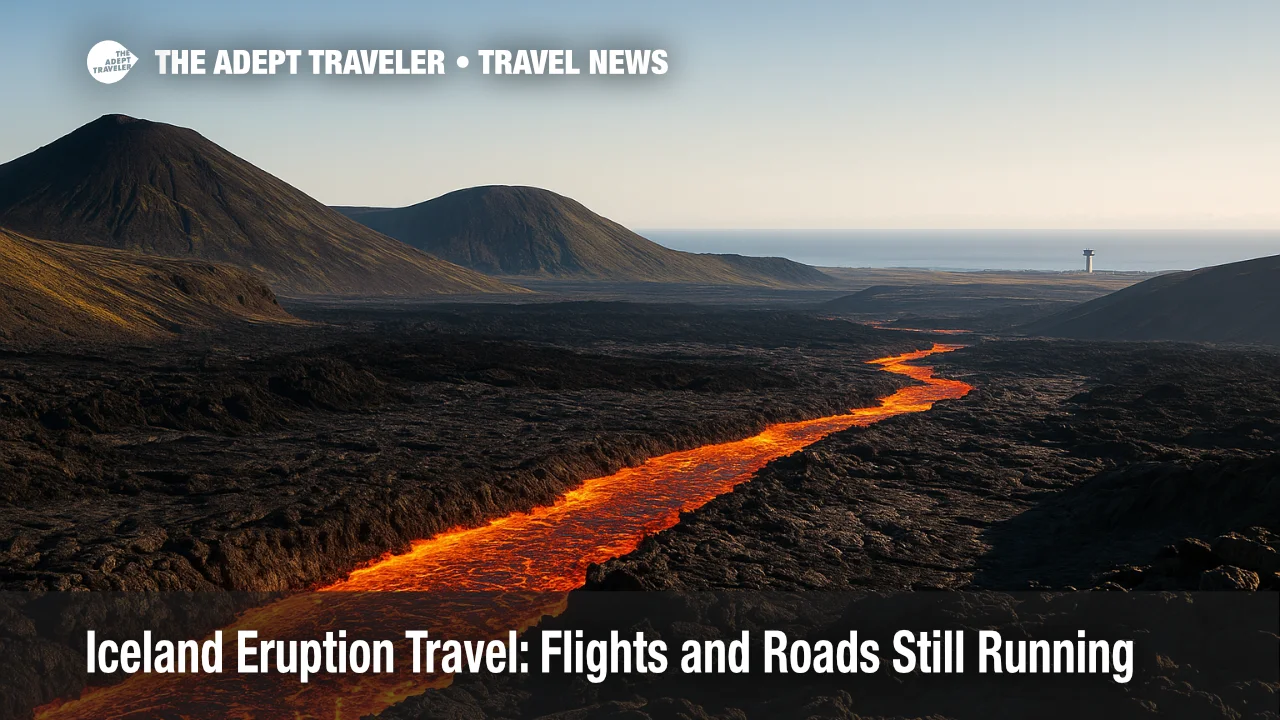Iceland Eruption Travel: Flights and Roads Still Running

The Sundhnúkur crater keeps glowing a vivid orange above Iceland's Reykjanes Peninsula, but for now the country's vital travel arteries are humming. Keflavík International Airport (KEF) is operating on schedule, rental-car lines are short, and Route 1 traffic still loops the island uninterrupted. Local officials warn that conditions can change fast, yet visitors willing to follow safety rules can watch lava flow in near-real time-sometimes before lunch and back in Reykjavík for dinner.
Key Points
- Why it matters: Iceland's busiest airport and ring road remain open despite the eruption.
- Travel impact: Lava is confined to uninhabited ground; no ash cloud threatens flights.
- What's next: Officials predict intermittent activity for weeks, and Blue Lagoon may close again with little notice.
- Guided hikes and helicopter rides give travelers safe viewing windows.
- Gas pollution can spike; vulnerable visitors should monitor forecasts daily.
Snapshot
Lava has poured from the Sundhnúkur fissure since July 16, 2025, the twelfth eruption on Reykjanes since 2021. Fountains now reach only a few yards high, but molten rivers still creep across freshly cooled crust. The Icelandic Meteorological Office says no homes or power lines are at risk. Flights at KEF and domestic hops at Reykjavík Airport operate normally because this is a low-ash fissure event. Road 43 to Grindavík reopened last week, though police maintain checkpoints that may close on short notice. The famed Blue Lagoon spa is open, yet managers review air-quality data every morning and evacuation drills continue.
Background
Reykjanes had been dormant for eight centuries until March 2021. Since then, magma has repeatedly cracked the peninsula's thin crust, producing mostly small, tourist-friendly eruptions. Unlike the ash-rich 2010 Eyjafjallajökull blast that paralyzed European aviation, these events emit limited fine particulate. Civil Protection built earthen berms to divert lava from the Svartsengi power plant and the Blue Lagoon, allowing tourism to rebound between flare-ups. Scientists now believe a multi-decade eruptive cycle has begun, turning this once-quiet corner into a living geology classroom-one that sits just 25 miles and a 45-minute drive from Iceland's main airport.
Latest Developments
Tours Move Quickly to the Lava
Reykjavik Excursions added extra departures of its "Volcanic Wonders with Grindavík Visit," a seven-hour outing that pairs a 3.4-mile guided hike to the active flow front with fish-and-chips in town. Groups carry gas meters, and departures are canceled if Civil Protection raises the alert. Seats run about $145 USD and often sell out two days ahead.
Helicopters Offer a 35-Minute Thrill
Norðurflug and Arctic Adventures now lift up to six passengers at a time for 30- to 35-minute fly-overs, departing Reykjavík Domestic Airport. At $536 USD a seat, the ride gives a panoramic look at the crater, new lava delta, and nearby geothermal fields while staying clear of gas plumes. Operators refund or reroute if visibility deteriorates.
Safety Do's and Don'ts
Authorities urge travelers to:
- Check Safetravel.is and Loftgaedi.is before leaving town for gas levels.
- Wear hiking boots, rain layers, eye protection, and a respirator if sulfur dioxide is elevated.
- Stay inside marked viewing zones; ground near fresh lava can collapse without warning.
- Respect closure signs and ember-hot rocks-thermal burns are the top injury reported by ICE-SAR.
Analysis
Iceland's tourism model-short haul from Europe, year-round flights from North America, and a near-urban volcano-turns a geologic hazard into a marketing asset. By containing lava within pre-planned barriers and limiting public access to supervised zones, officials keep risk low while selling unforgettable experiences. Airlines avoid costly ash disruptions, and tour operators pivot quickly between hiking, super-jeep, and aerial products to match safety advice. The greatest variable now is air quality. SO₂ spikes can close trails or the Blue Lagoon with an hour's notice, an operational nightmare for day-trip planners but a manageable inconvenience compared with wholesale flight cancellations. For travel advisors, the best play is to book flexible tours, remind clients to pack N95 masks, and build in an extra night near KEF in case weather or gas triggers sudden route changes.
Final Thoughts
As long as fissure eruptions keep ash out of the jet stream, Iceland will remain both spectacular and surprisingly easy to visit. With flights steady, roads clear, and vetted guides ready, travelers can witness raw geology without sacrificing their itineraries-so long as they respect the island's ever-changing moods and stay nimble around fluid Blue Lagoon schedules. Pack layers, monitor Safetravel alerts, and you will come home bragging about front-row seats to an active volcano while the rest of your holiday ran right on time-proof that Iceland eruption travel can be thrilling, safe, and convenient all at once.
Sources
- Eruption ongoing on the Sundhnúkur crater row - Icelandic Meteorological Office
- Iceland volcano emits smoke and glowing lava in 12th eruption since 2021 - Reuters
- Eruption at the Sundhnúkur Crater Row update - Visit Reykjanes
- Seismic Activity Information - Blue Lagoon Iceland
- Iceland Volcanic Activity Updates 2025 - Icelandair
- Volcanic Wonders with Grindavík Visit tour - Reykjavik Excursions
- 35-Minute Helicopter Tour Over Iceland's New Volcanic Eruption - Arctic Adventures
